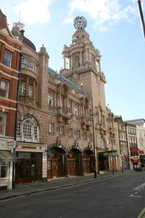The London Coliseum
Frank Matcham
alias English National Opera, Coliseum TheatreSt Martin's Lane, | |
| show on the map | http://www.eno.org/home.php |
Important events
People
History
Frank Matcham's London Coliseum (1904) represents the next step after the fully developed nineteenth-century opera house - The introduction of cantilevering and the abolition of boxes has made possible three immensely deep galleries, every seat of which faces approximately forward. But this brings with it new problems which Matcham fails to solve entirely satisfactorily. Rather than leave the side walls bare, he adds a few pseudo-boxes, the uppermost perched unhappily on the canopies of those beneath. And the two awkward corners that remain next to the proscenium arch are disguised by the desperate expedient of placing lion-drawn chariots on them. Nevertheless, Matcham possessed the secret of theatrical glamour, which overrules all objections.
In: Tidworth, Simon : Theatres: An Illustrated History. London 1973 p. 184
Author: Simon Tidworth
Simon Tidworth:
religious structures, Palais Garnier, Théâtre du Vieux-Colombier, Semper Opera House, Teatro alla Scala, Verona Philharmonic Theatre, Teatro El Buen Retiro, Malmö Municipal Theatre, People's Theatre, National Opera of Bordeaux, Musical Theatre of Besançon, Opernhaus auf der Cortina, Theatre Royal, The London Coliseum, Opernhaus in Salvatorplatz, Stuttgart State OperaAdditional information
No information has yet been entered
Add information














